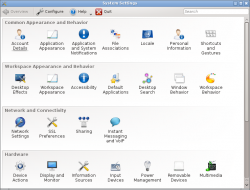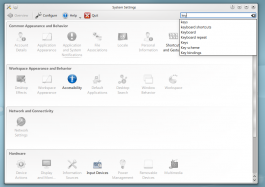System Settings/de: Difference between revisions
(Created page with "[[Category:Arbeitsfläche/de ]] Category:System/de Category:Konfiguration/de Category:Reparaturarbeiten notwendig/de") |
(Updating to match new version of source page) |
||
| Line 159: | Line 159: | ||
|} | |} | ||
<span class="mw-translate-fuzzy"> | |||
[[Category:Arbeitsfläche/de ]] | [[Category:Arbeitsfläche/de ]] | ||
[[Category:System/de]] | [[Category:System/de]] | ||
[[Category:Konfiguration/de]] | [[Category:Konfiguration/de]] | ||
[[Category:Reparaturarbeiten notwendig/de]] | [[Category:Reparaturarbeiten notwendig/de]] | ||
</span> | |||
Revision as of 11:00, 17 May 2012
Funktionen
- Kontrollzentrum für globale KDE Plattform Einstellungen
- Anpassen und Verwalten Ihres Desktops an einer Stelle
- Suchfunktionen helfen beim besseren Finden von Einstellungen
Suche
Systemeinstellungen hat eine Suchfunktion, um eine Einstellung besser zu finden. Tippen Sie einfach ein Stichwort in das Suchfeld in der Werkzeugleiste ein und Systemeinstellungen wird Ihnen entsprechende Module anzeigen, die das Stichwort enthalten und Module ausblenden, die es nicht enthalten. Systemeinstellungen Module können ebenso durch KRunner erreicht werden.
You can also search for and open System Settings modules in KRunner.
Kategorien
Gemeinsame Darstellung und Verhalten
{{{3}}}
[[File:{{{2}}}|48px|link=Special:myLanguage/System Settings/Account Details]] Konfigurieren Sie Ihre Benutzerinformationen, Kennwort und Pfade. Sie können ebenso Ihren Sozialen-Desktop-Anbieter einstellen. {{{3}}}
[[File:{{{2}}}|48px|link=Special:myLanguage/System Settings/Application Appearance]] Konfigurieren Sie Ihr Programm Style, Farben, Symbole, Schriftarten und Smileys. Application and System Notifications

Configure the notifications you want to receive from the system, and from applications File Associations

Set default actions and icons for different types of files. Locale

Language, numeric, and time setting for your particular region. Allows you to apply translation (locale) to whole KDE Desktop or change spellchecker parameters. Personal Information

Configure the resources used to manage your address book, calendar, and notes Shortcuts and Gestures

Configure keyboard shortcuts and mouse gestures.
Workspace Appearance and Behaviour
Desktop Effects

Configure desktop effects such as window animations, transparency, or the desktop cube. Workspace Appearance

Configure the appearance of windows, cursors, and the desktop. Accessibility

Settings to help users who have difficulty hearing audible cues, or who have difficulty using a keyboard. Default Applications

Set the default applications for common tasks, such as browsing the web, writing email, or managing files. Search Desktop

Settings for the desktop search engine. Window Behaviour

Configure task switching, and how windows respond to mouse actions. Workspace Behaviour

Settings for overall workspace behaviour and virtual desktops.
Network and Connectivity
Bluetooth

Use Bluedevil to set up connections to your Bluetooth devices. Network Settings

Preferences for your network connections and proxy settings. SSL Preferences

Manage SSL certificates. Sharing

Settings for sharing files with Windows machines over a network.
Hardware
Device Actions

Configure which actions are available when a new device is connected to your machine. Digital Camera

Settings for connecting to your digital cameras. Display and Monitor

Configuration of your monitor(s) and screensaver settings. Information Sources

Configuration of hardware for network, remote control, and modems. {{{3}}}
[[File:{{{2}}}|48px|link=Special:myLanguage/System Settings/Input Devices]] Konfigurieren Sie Ihre Tastatur, Maus und Joystick. Power Management

Global settings for the power manager. Removable Devices

Configure automatic handling of removable storage media. Multimedia

Configure the handling of audio CDs
System Administration
Actions Policy

Configure policies for trusted actions in the system. Date & Time

Settings for date and time. Font Installer

Install, manage, and preview fonts. Global Policy Configurations

Configure global settings for system policies. {{{3}}}
[[File:{{{2}}}|48px|link=Special:myLanguage/System Settings/Login Screen]] Die Anmeldeverwaltung (KDM) einstellen. Permissions

Software Management

Get and remove software, and manage automatic updating of software. {{{3}}}
[[File:{{{2}}}|48px|link=Special:myLanguage/System Settings/Startup and Shutdown]] Configure your system behavior when starting up or shutting down.
[[Category:Arbeitsfläche/de ]]



